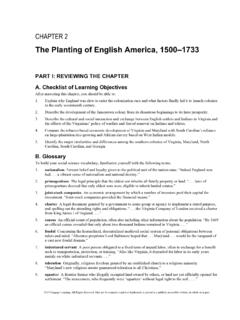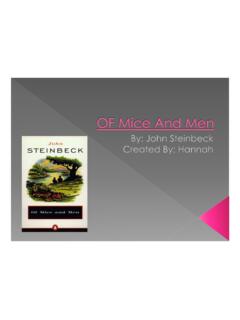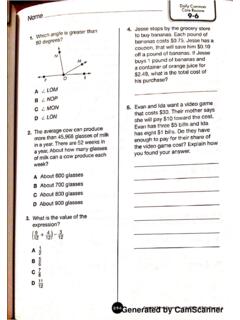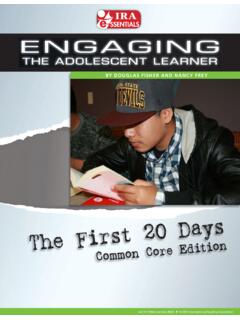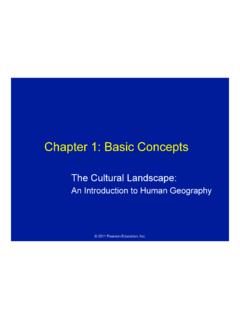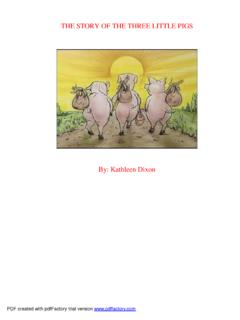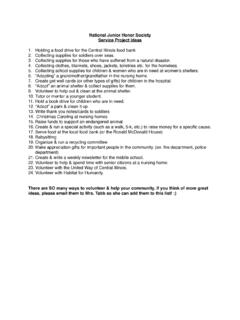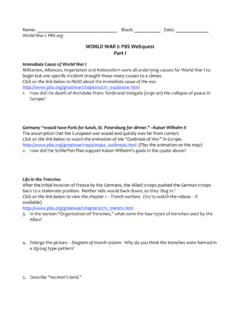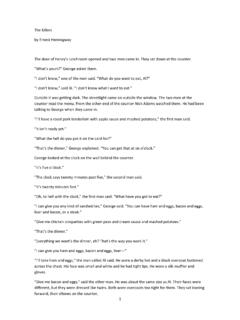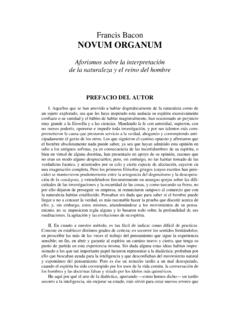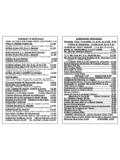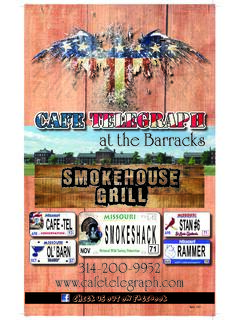Transcription of The Scientific Revolution - Springfield Public Schools
1 Page 1 of 6. 1. The Scientific Revolution MAIN IDEA WHY IT MATTERS NOW TERMS & NAMES. SCIENCE AND TECHNOLOGY In Such questioning led to the geocentric heliocentric theory the mid-1500s, scientists began development of the Scientific theory Galileo Galilei to question accepted beliefs and method still in use today. Scientific Scientific method make new theories based on Revolution Isaac Newton experimentation. SETTING THE STAGE As you recall, the period between 1300 and 1600 was a time of great change in Europe. The Renaissance, a rebirth of learning and the arts, inspired a spirit of curiosity in many fields. Scholars began to question ideas that had been accepted for hundreds of years. Meanwhile, the religious move- ment known as the Reformation prompted followers to challenge accepted ways of thinking about God and salvation.
2 While the Reformation was taking place, another Revolution in European thought had begun, one that would permanently change how people viewed the physical world. The Roots of Modern Science TAKING NOTES. Analyzing Causes Use a Before 1500, scholars generally decided what was true or false by referring to an diagram to list the events ancient Greek or Roman author or to the Bible. Few European scholars chal- and circumstances that led lenged the Scientific ideas of the ancient thinkers or the church by carefully to the Scientific Revolution . observing nature for themselves. The Medieval View During the Middle Ages, most scholars believed that the earth was an immovable object located at the center of the universe. According to that belief, the moon, the sun, and the planets all moved in perfectly circular Causes of the Scientific Revolution paths around the earth.
3 Common sense seemed to support this view. After all, the sun appeared to be moving around the earth as it rose in the morning and set in the evening. This earth-centered view of the universe was called the geocentric theory. The idea came from Aristotle, the Greek philosopher of the fourth century The Greek astronomer Ptolemy (TOL a mee) expanded the theory in the second century In addition, Christianity taught that God had deliberately placed the earth at the center of the universe. Earth was thus a special place on which the great drama of life unfolded. A New Way of Thinking Beginning in the mid-1500s, a few scholars published works that challenged the ideas of the ancient thinkers and the church. As these scholars replaced old assumptions with new theories, they launched a change in European thought that historians call the Scientific Revolution .
4 The Scientific Revolution was a new way of thinking about the natural world. That way was based upon careful observation and a willingness to question accepted beliefs. Enlightenment and Revolution 623. Page 2 of 6. A combination of discoveries and circumstances led to the Scientific Revolution and helped spread its impact. During the Renaissance, European explorers traveled to Africa, Asia, and the Americas. Such lands were inhabited by peoples and ani- mals previously unknown in Europe. These discoveries opened Europeans to the possibility that there were new truths to be found. The invention of the printing press during this period helped spread challenging ideas both old and new . more widely among Europe's thinkers. The age of European exploration also fueled a great deal of Scientific research, especially in astronomy and mathematics.
5 Navigators needed better instruments and geographic measurements, for example, to determine their location in the open sea. As scientists began to look more closely at the world around them, they made observations that did not match the ancient beliefs. They found they had reached the limit of the classical world's knowledge. Yet, they still needed to know more. A Revolutionary Model of the Universe An early challenge to accepted Scientific thinking came in the field of astronomy. It started when a small group of scholars began to question the geocentric theory. The Heliocentric Theory Although backed by authority and common sense, the geocentric theory did not accurately explain the movements of the sun, moon, and planets. This problem troubled a Polish cleric and astronomer named Nicolaus Copernicus (koh PUR nuh kuhs).
6 In the early 1500s, Copernicus became interested in an old Greek idea that the sun stood at the center of the universe. After studying planetary movements for more than 25 years, Copernicus reasoned that indeed, the stars, the earth, and the other planets revolved around the sun. Copernicus's heliocentric, or sun- centered, theory still did not com- pletely explain why the planets Venus Earth the stars orbited the way they did. He also Saturn Mars Sun Mercury Jupiter knew that most scholars and clergy would reject his theory because it This model contradicted their religious views. shows how Fearing ridicule or persecution, Copernicus did not publish his findings until 1543, Copernicus saw the planets revolving the last year of his life. He received a copy of his book, On the Revolutions of the around the sun.
7 Heavenly Bodies, on his deathbed. While revolutionary, Copernicus's book caused little stir at first. Over the next century and a half, other scientists built on the foundations he had laid. A Danish astronomer, Tycho Brahe (TEE koh brah), carefully recorded the movements of the planets for many years. Brahe produced mountains of accurate data based on his observations. However, it was left to his followers to make mathematical sense of them. After Brahe's death in 1601, his assistant, a brilliant mathematician named Johannes Kepler, continued his work. After studying Brahe's data, Kepler concluded Recognizing that certain mathematical laws govern planetary motion. One of these laws showed Effects How did that the planets revolve around the sun in elliptical orbits instead of circles, as was Kepler's findings previously thought.
8 Kepler's laws showed that Copernicus's basic ideas were true. support the helio- They demonstrated mathematically that the planets revolve around the sun. centric theory? 624 Chapter 22. Page 3 of 6. Galileo's Discoveries An Italian scientist named Galileo Galilei built on the new theories about astronomy. As a young man, Galileo learned that a Dutch lens maker had built an instrument that could enlarge far-off objects. Galileo built his own telescope and used it to study the heavens in 1609. Then, in 1610, he published a small book called Starry Messenger, which described his astonishing observations. Galileo announced that Jupiter had four moons and that the sun had dark spots. He also noted that the earth's moon had a rough, uneven surface. This shattered Aristotle's theory that the moon and stars were made of a pure, perfect substance.
9 Galileo's observations, as well as his laws of motion, also clearly supported the theories of Copernicus. Conflict with the Church Galileo's findings frightened both Catholic and Protes- tant leaders because they went against church teaching and authority. If people believed the church could be wrong about this, they could question other church teachings as well. In 1616, the Catholic Church warned Galileo not to defend the ideas of Copernicus. Although Galileo remained publicly silent, he continued his studies. Then, in 1632, he published Dialogue Concerning the Two Chief World Systems. This book presented the ideas of both Copernicus and Ptolemy, but it clearly showed that Galileo supported the Copernican theory. The pope angrily summoned Galileo to Rome to stand trial before the Inquisition.
10 Galileo stood before the court in 1633. Under the threat of torture, he knelt before the cardinals and read aloud a signed confession. In it, he agreed that the ideas of Copernicus were false. PRIMARY SOURCE. Analyzing With sincere heart and unpretended Primary Sources faith I abjure, curse, and detest the In what two aforesaid errors and heresies [of ways does Galileo Copernicus] and also every other error seek to appease .. contrary to the Holy Church, and I. the Church? swear that in the future I will never again say or assert .. anything that might cause a similar suspicion toward me. GALILEO GALILEI, quoted in The Discoverers Galileo was never again a free man. He lived under house arrest and died in 1642 at his villa near Florence. However, his books and ideas still spread all over Europe.
